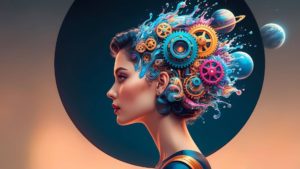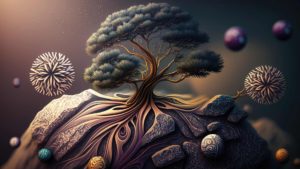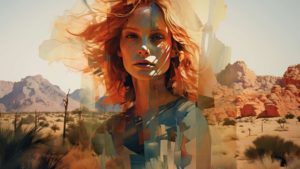When technology is being discussed, the emergence of AI-generated art becomes one of the noticeable things. This aspect is tremendously seen on social media platforms and circulates in the world of digitalization.
This format has some people wondering if it is actually art. Ultimately, art has always been regarded as a means of expressing the feelings, ideas, and experiences of the creator. Can a machine that has no feelings or life experience create something meaningful? Or is artificial intelligence just a tool that expands the possibilities of human creativity?
The best answer to this AI-generated creativity is the concept of co-creation. Although human creativity has always been reflected in art, Artificial intelligence in art has emerged as a new partner in recent years that facilitates human creativity in this field. Machines are increasingly exploring and even expanding what was formerly the domain of human imagination and expertise. Though it may sound like science fiction, AI-generated art is rapidly becoming a reality and changing our perceptions of artistic expression, creativity, and the place of technology in our lives.
The idea is straightforward. AI can create original artwork by analyzing large volumes of visual input utilizing algorithms and statistics. These works, which can be anything from abstract pictures to lifelike portraits, are frequently produced in a matter of seconds using very little coding on Artificial intelligence in art.
Though it may initially appear that AI is just copying patterns or trends, the reality is far more intricate. AI is more than just repeating; it is also learning, developing, and in certain situations, creating art that even the technology’s developers are surprised to see.
The emergence of AI-generated art has some people wondering if it is actually art. Ultimately, art has always been regarded as a means of expressing the feelings, ideas, and experiences of the creator. Can a machine that has no feelings or life experience create something meaningful? Or is artificial intelligence just a tool that expands the possibilities of human creativity?
AI-generated skill presents new opportunities for designers, artists, and anybody else with a creative spark.
AI-Generated Art: How to make AI art?

The technique of integrating artistic talent with machine learning algorithms to create AI-created art can be interesting.
This is a step-by-step guide on creating artificial intelligence art, with an emphasis on resources and methods that are easily accessible to both beginners and experts:
-
Select Your AI Drawing Tool
Numerous AI-based tools and platforms are available to assist in creating Artificial intelligence in art. Among the most popular AI-generated ones are:
- OpenAI’s DALL·E 2: It creates incredibly detailed graphics based on text prompts.
- DeepArt: It uses renowned artistic styles to turn your images into works of art.
- Artbreeder: Allows you to combine and tweak existing images to create new ones.
- Runway ML: With the help of this, AI models for image generation can be easily trained.
- DeepDream: A program developed by Google to produce abstract, dream-like pictures.
Each tool offers different functions. For instance, some allow you to give the AI a language prompt to create an image, while others can ask you to upload an image so that neural networks or filters can be applied to it.
-
Enter an image or text prompt
The majority of AI-generated art tools offer you two primary ways to get started:
Text-Based Art Generation: You can describe what you want with tools like DALL·E or MidJourney, and Artificial intelligence in art will create an image based on your description. You could type “Moon over a marvelous mountain range,” for instance, to see how the AI understands what you have said.
Image-Based Transformation: You can input a photo and add a distinctive style to it using AI-generated art programs like DeepArt or DeepDream. This might be anything from using AI advancements to make your image abstract to giving it the look of a “Monet painting.”
-
Try Different Prompts and Settings in AI-generated art tools
The output of text-based generators is dependent on the quality and originality of the input. Be suggestive and try out various components:
Simple Descriptions: Begin with a simple concept, such as “a jar balanced on a window ledge.”
Incorporate Artistic Elements: Bring your prompt to life with artistic aspects such as “a painter-inspired unreal image depicting a moon sight from a window.”
Modify Parameters: A few tools let you change things like complexity, texture, or style. You can modify the image and get different effects by experimenting with these.
-
Edit and refine
Most AI-generated art platforms let you tweak the artwork a little once the AI creates it. Like;
Color, contrast, and brightness adjustments can be made using the built-in editors of many applications once the image has been AI-generated.
Combine Multiple photos: You can create a unique final artwork by combining features from multiple AI-generated photos using tools like Artbreeder.
Modify the Style: After the image is made, certain platforms permit additional stylistic adjustments, such as going from a “realistic” to a “painterly” appearance.
Once you are content with the AI-generated artwork, you can print or share the high-resolution version by downloading it. You can choose whether to upgrade for better quality photographs or more features since many tools provide both free and premium options.
Nonetheless, there is a piece of successful advice to get the best from AI-generated art tools.
- Repeat and Improve: Creating AI-generated art frequently involves making mistakes. To achieve the greatest outcomes, don’t be afraid to experiment with different prompts and settings.
- Blend AI with Human Creativity: AI art can also help as a basis. You can use conventional tools like Photoshop, painting, or drawing to improve the AI-generated image.
- Use High-Quality Inputs: To receive the best results from an image-based application, make sure the image you are utilizing is of a high enough quality.
AI capabilities combined with human ideas can create one-of-a-kind AI-generated artwork that highlights the fascinating cooperation between humans and machines.
The field of art is changing in ways that were previously unthinkable due to Artificial intelligence in art. AI-generated art creates works that challenge our conceptions of creativity by fusing the inventiveness of human artists with the raw processing power of machines.
Nonetheless, it is wise to note that artificial intelligence in art provides new avenues for artistic exploration of creativity. Many artists are embracing technology as a tool that improves their work rather than seeing it as a threat. Artists can create a wider range of works by experimenting with various forms, textures, and concepts when they work in cycle with AI.
While some artists let the computer take the lead and steer the creative process in unexpected areas, others use AI to generate the basic stages of their art, which they then improve and customize.
AI-Generated Art in online platforms

AI-generated art has found a home on online art platforms, where digital galleries, markets, and NFTs (non-fungible tokens) provide new avenues for the purchase, distribution, and exchange of AI art. Because AI art is digital, it is ideal for these online spaces where both collectors and artists may interact with the pieces in new and creative ways. The technological and digital world can acknowledge this work of art better. Uniqueness and the incorporation of technology are highly valued in the NFT community, where AI-generated art has also garnered a significant following.
New markets have emerged as a result of AI-generated NFTs, and collectors are keen to acquire a piece of this innovative mix of art and technology.
Artificial intelligence in art has made it simple for artists to produce digital works, mint them as NFTs, and sell them on blockchain-based marketplaces, avoiding the need for conventional gatekeepers like museums and auction houses. A broader spectrum of artists is now able to present their work to audiences around the world because of this decentralization of the art market. However, it does not mean the traditional means are compromised because of AI-generated art tools. They have their own recognized audience.
The Creative Process: An Interaction between People and Technology

These partnerships of AI-generated art tools and people turn the creative process into a conversation between machine learning and human intent. While artists define the criteria, select the materials, and polish the results, artificial intelligence frequently adds an element of uncertainty. The magic happens in this unpredictable way because AI may create combinations of colors, textures, or forms that would never have occurred to the human mind, giving artists new directions to explore. AI is viewed by many artists as a means of overcoming creative blockages, questioning preconceptions, or investigating genres they had not before explored.
An artist may, for instance, take a basic sketch and feed it into an AI-generated art model that has been trained on thousands of well-known pieces of art.
After that, the Artificial intelligence in art creates concept versions that the artist can then improve.
Some artists go one step further and give the AI more control over the creative process. They might let the machine take the lead rather than just directing it, seeing the AI as a partner that offers a fresh kind of creative autonomy. These questions established ideas of generation because the finished work is now the result of collaboration between the artist and a computer rather than just the work of human hands.
AI-Generated Art: Is AI Really Capable of Creativity?

A significant query has surfaced as artificial intelligence continues to reshape sectors and infuse the creative sector: Is AI really creative? AI-Generated Art poetry, composition, art, and even writing can seem remarkably unique at first. But does that suggest that machines are creative beings, or are they just copying the patterns and styles that humans provide? Deep philosophical discussions concerning the nature of creativity itself that is, whether it is a characteristic unique to humans or something that can be recreated by machines like AI-generated things using complex algorithms—are touched upon by this question.
Beyond AI-generated art, The definition of creativity is at the center of the argument. Historically, creativity has been defined as the distinctly human ability to come up with novel and creative ideas, frequently motivated by feelings, instincts, and personal experience. Human creativity is thought to be highly individualized, impulsive, and shaped by perception, culture, and society. It is believed to be a process that involves deeper emotional depth and subjective experiences in addition to simple logic and calculation.
Conversely, artificial intelligence functions within the parameters of data and algorithms. By rearranging the components of the data it was trained on, it recognizes patterns, spots trends, and creates original content. Some find this method creative since the results can be very stunning, either theoretically or visually.
Nonetheless, Unquestionably, Artificial intelligence in art is enhancing our understanding of creativity despite these philosophical obstacles. Whether we accept AI-generated art as authentically creative or not, it is changing the creative process in ways that can have a significant impact on the direction of literature, music, and the arts in the future. The increasing involvement of AI-generated art is creating new opportunities for human artists, enabling human-machine collaborations that have the potential to completely transform the creative sectors.
In the end, how we define creativity can determine whether Artificial intelligence in art is genuinely creative or not. AI is unlikely to ever reach true originality if we consider creativity to be an emotional, conscious activity connected to human experience.
However, if we take a broader definition of creativity, which is the capacity to produce original, valuable ideas, then artificial intelligence (AI) may already be displaying creative potential, if not in the same way as humans.
Either way, our beliefs about art, uniqueness, and what it means to be creative in the digital age are being called into question by expanding the participation of AI-generated art in the creative process.













